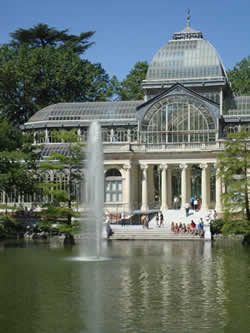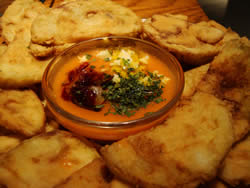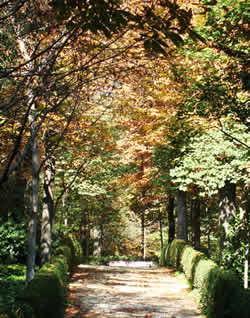- Home » Expat Articles » Interviews » Repat Interview with Dana, US Expat Returned from Spain
Repat Interview with Dana, US Expat Returned from Spain
| Published: | 17 Sep at 9 AM |
Want to get involved?
Become a Featured Expat and take our interview.
Become a Local Expert and contribute articles.
Get in touch today!
Become a Local Expert and contribute articles.
Get in touch today!
Filed: Interviews,Spain
Dana recently moved back to the United States from Madrid, where she had a blast shopping, eating tapas, traveling, speaking Spanish, and blogging about life abroad. Now, she's in graduate school at The University of Chicago studying neurobiology and taking trips around the United States. Dana Goes to Madrid shares the stories and travel tips from Dana\'s adventures beginning in Spain and expanding to the rest of Europe, northern Africa, Southeast Asia, the Middle East, Central America, and North America. The blog's current focus is a series of posts dedicated to the many neighborhoods that make up Chicago. Dana's expat blog is called Dana Goes to Madrid! (see listing here)
Where are you originally from?
I grew up in the United States.
In which country and city are you living now?
I was living abroad in Madrid and am now back in the United States for graduate school in Chicago.
How long did you live in Madrid?
I lived in Madrid for about one year and recently moved to Chicago for graduate school in neurobiology. After that, I might apply for jobs somewhere with a warmer winter...or no winter at all!
Did you bring family with you to Spain?
When I moved abroad to Madrid, I didn't bring anyone with me. I just got a job, hopped on a plane, and went. Only when the plane was finally taking off for Europe did I start to feel nervous about living so far away from my family for an entire year. Fortunately, I was able to call them on Skype.
How did you find the transition to living in a foreign country?
When I moved to Madrid, I began to notice that it's the little things that make you realize you live in a foreign country. Things like drying clothes on a clothesline or buying a paella mix at the grocery store are little, but constantly remind you that you're not at home. Other changes provided exciting opportunities for personal growth such as adjusting to speaking Spanish all day everyday and trying out the brightly colored clothing style.
Was it easy making friends and meeting people; do you mainly socialise with other expats?
I found that most people were very friendly and curious about me as a foreigner. Often though, this friendly reception did not extend to an actual friendship. Most of the wonderful friends I did make were through contacts from home. Apart from them, on my weekend trips, I socialized with everyone I met in youth hostels. Sometimes we even explored the cities we visited in groups if our plans were similar.
What are the best things to do in Madrid; anything to recommend to future expats?
For anyone visiting Madrid, I would definitely recommend visiting the Parque del Retiro, a wonderfully relaxing park with rowboats and walking trails. In the park, I always enjoyed visiting the Palacio de Cristal, a palatial structure made of glass in the middle of the park's forests. The Palacio de Cristal is an extension of the Museo de la Reina Sofía, which I also recommend visiting, where they display a different art exhibit every few months. The Museo de la Reina Sofía is my favorite museum in Madrid; it has lots of contemporary art including Picasso's famous Guernica.
I also really enjoyed shopping around the Plaza de Callao (metro: Callao) and on c/Fuencarral (metro: Gran Vía). There, you can find my favorite Spanish store, Desigual, which sells elaborately patterned, colorful clothing, accessories, and amazing jackets. There's also a wide variety of other stores selling clothes, cosmetics, and accessories of a range of qualities and prices. On c/Fuencarral is Lateral, one of my favorite tapas restaurants.

El Palacio de Cristal (Crystal Palace) in Madrid's Parque del Retiro. The palace is an extension of the Museo de la Reina Sofía and hosts modern art exhibits.What did you enjoy most about living in Spain?
Some of my favorite parts of life in Madrid are the forward-pushing fashions and bright colors, the absence of snow in winter, the emphasis on being outside whenever the weather permits (almost always), and, of course, the tapas. I think it's fantastic that the city is very walkable and when you don't feel like walking, you can hop on the metro, which provides clean, safe transportation to all parts of the city.
How does the cost of living in Madrid compare to the US?
I have found living in Madrid to be much cheaper than living in Chicago, mainly because of the difference in rent. Since rent is generally my largest expense, paying Madrid's comparatively low rent freed up extra money for traveling. Plane tickets for travel around Europe are also much cheaper than plane tickets for travel within the US. During my weekend trips, I have found other cities (Zurich, Oslo, and London) to be very expensive, but I suppose if I lived there and had a job there, my salary would be proportional to the higher cost of living.
What negatives, if any, were there to living in Madrid?
Madrid is awesome! The only downside I can think of is that when you hang your laundry on a clothesline to dry, there's always a small danger that it might blow away. One other thing that's a little weird, but not necessarily negative, is the practice involved with renting a room in an apartment in Madrid. In my apartment, one of the roommates held the lease and account for all the utilities, and the rest of us paid that roommate each month. Technically, I guess I never "officially" lived there. In the US, living that way would really concern me, but in Spain, it seems to be a very common practice.
If you could pick one piece of advice to anyone moving there, what would it be?
Pack durable, comfortable walking shoes. The old stone streets really wear down your shoes, so strappy sandals or thin heels won't work well. Much of the city is walkable, and being outside is a big part of life in Madrid. Exploring the sights is always more fun when you're feet don't hurt, so pack accordingly...or do some shoe shopping!
What has been the hardest aspect to your expat experience so far?
I'm very close with my family. Seeing my parents only one time during the year was difficult for me. I'm very glad that they came to visit me so I could show them around Madrid and take them to all my favorite tapas bars, shops, museums, and of course the Retiro.
How did you cope with US repatriation?
For me, coming home is always easy. Because it's home. Home is my place, so it has always felt really normal for me to be there. There's something really fantastic in knowing that your family, or even any familiar face, is there eagerly waiting to meet you at the airport when your plane descends from the clouds. When I first returned to the US, I was actually exhausted from my break-neck pace of traveling. I loved visiting a different country or city almost every weekend for so many months, but also felt very excited to refresh myself with the calmness and stability that comes from lounging on my couch next to our adorable beagle.
Coming home this time was a bit different. When I came home from Madrid, I only stayed for about 70 hours before hopping on another flight to Asia. There, I toured Vietnam, Cambodia, and Taiwan for about a month, trading in that calm feeling of beagle cuddling for my first fantastic Asian adventure. When I returned, after a week-long stop in San Francisco and a day trip to Napa, my family and I started driving to Miami to drop my sister off at college, and then visited Sanibel Island, Charleston, and Asheville on the way home. By the time I arrived home in my actual house with the little beagle, I felt happy, but still very confused about what time zone I was in. For a short while, I didn't even want to look at an airplane.
A couple months later; however, my globe-trotting spirit returned in full force as I dreamed up future trips to St. Petersburg, Giza, The Galapagos Islands, Buenos Aires, Boston, and about ten other places. The more places I see, the more places I want to see!

'Berenjenas con salmorejo' - Fried eggplant slices and salmorejo. Salmorejo comes from Córdoba and is a cold soup that is a bit thicker than gazpacho. This picture is from Lateral, a restaurant on c/Fuencarral, one of my favorite places to eat tapas.What are your top expat tips for anyone following in your footsteps?
Tell us a bit about your own expat blog.
Dana Goes to Madrid! shares tales from a globe-trotter who enjoys photography, food, ballet, architecture, and exploring new places. It includes travel stories and tips for Europe, Asia, Central America, Africa, North America, and the Middle East. Formerly, I wrote about my life in Madrid and abroad, and now my blog presents a series of posts about the neighborhoods of Chicago.
How can you be contacted for further advice to future expats coming to your area?
I love chatting about travel! Contact me via my blog (see link below)
Here's the interview with Dana...
Where are you originally from?
I grew up in the United States.
In which country and city are you living now?
I was living abroad in Madrid and am now back in the United States for graduate school in Chicago.
How long did you live in Madrid?
I lived in Madrid for about one year and recently moved to Chicago for graduate school in neurobiology. After that, I might apply for jobs somewhere with a warmer winter...or no winter at all!
Did you bring family with you to Spain?
When I moved abroad to Madrid, I didn't bring anyone with me. I just got a job, hopped on a plane, and went. Only when the plane was finally taking off for Europe did I start to feel nervous about living so far away from my family for an entire year. Fortunately, I was able to call them on Skype.
How did you find the transition to living in a foreign country?
When I moved to Madrid, I began to notice that it's the little things that make you realize you live in a foreign country. Things like drying clothes on a clothesline or buying a paella mix at the grocery store are little, but constantly remind you that you're not at home. Other changes provided exciting opportunities for personal growth such as adjusting to speaking Spanish all day everyday and trying out the brightly colored clothing style.
Was it easy making friends and meeting people; do you mainly socialise with other expats?
I found that most people were very friendly and curious about me as a foreigner. Often though, this friendly reception did not extend to an actual friendship. Most of the wonderful friends I did make were through contacts from home. Apart from them, on my weekend trips, I socialized with everyone I met in youth hostels. Sometimes we even explored the cities we visited in groups if our plans were similar.
What are the best things to do in Madrid; anything to recommend to future expats?
For anyone visiting Madrid, I would definitely recommend visiting the Parque del Retiro, a wonderfully relaxing park with rowboats and walking trails. In the park, I always enjoyed visiting the Palacio de Cristal, a palatial structure made of glass in the middle of the park's forests. The Palacio de Cristal is an extension of the Museo de la Reina Sofía, which I also recommend visiting, where they display a different art exhibit every few months. The Museo de la Reina Sofía is my favorite museum in Madrid; it has lots of contemporary art including Picasso's famous Guernica.
I also really enjoyed shopping around the Plaza de Callao (metro: Callao) and on c/Fuencarral (metro: Gran Vía). There, you can find my favorite Spanish store, Desigual, which sells elaborately patterned, colorful clothing, accessories, and amazing jackets. There's also a wide variety of other stores selling clothes, cosmetics, and accessories of a range of qualities and prices. On c/Fuencarral is Lateral, one of my favorite tapas restaurants.

El Palacio de Cristal (Crystal Palace) in Madrid's Parque del Retiro. The palace is an extension of the Museo de la Reina Sofía and hosts modern art exhibits.
Some of my favorite parts of life in Madrid are the forward-pushing fashions and bright colors, the absence of snow in winter, the emphasis on being outside whenever the weather permits (almost always), and, of course, the tapas. I think it's fantastic that the city is very walkable and when you don't feel like walking, you can hop on the metro, which provides clean, safe transportation to all parts of the city.
How does the cost of living in Madrid compare to the US?
I have found living in Madrid to be much cheaper than living in Chicago, mainly because of the difference in rent. Since rent is generally my largest expense, paying Madrid's comparatively low rent freed up extra money for traveling. Plane tickets for travel around Europe are also much cheaper than plane tickets for travel within the US. During my weekend trips, I have found other cities (Zurich, Oslo, and London) to be very expensive, but I suppose if I lived there and had a job there, my salary would be proportional to the higher cost of living.
What negatives, if any, were there to living in Madrid?
Madrid is awesome! The only downside I can think of is that when you hang your laundry on a clothesline to dry, there's always a small danger that it might blow away. One other thing that's a little weird, but not necessarily negative, is the practice involved with renting a room in an apartment in Madrid. In my apartment, one of the roommates held the lease and account for all the utilities, and the rest of us paid that roommate each month. Technically, I guess I never "officially" lived there. In the US, living that way would really concern me, but in Spain, it seems to be a very common practice.
If you could pick one piece of advice to anyone moving there, what would it be?
Pack durable, comfortable walking shoes. The old stone streets really wear down your shoes, so strappy sandals or thin heels won't work well. Much of the city is walkable, and being outside is a big part of life in Madrid. Exploring the sights is always more fun when you're feet don't hurt, so pack accordingly...or do some shoe shopping!
What has been the hardest aspect to your expat experience so far?
I'm very close with my family. Seeing my parents only one time during the year was difficult for me. I'm very glad that they came to visit me so I could show them around Madrid and take them to all my favorite tapas bars, shops, museums, and of course the Retiro.
How did you cope with US repatriation?
For me, coming home is always easy. Because it's home. Home is my place, so it has always felt really normal for me to be there. There's something really fantastic in knowing that your family, or even any familiar face, is there eagerly waiting to meet you at the airport when your plane descends from the clouds. When I first returned to the US, I was actually exhausted from my break-neck pace of traveling. I loved visiting a different country or city almost every weekend for so many months, but also felt very excited to refresh myself with the calmness and stability that comes from lounging on my couch next to our adorable beagle.
Coming home this time was a bit different. When I came home from Madrid, I only stayed for about 70 hours before hopping on another flight to Asia. There, I toured Vietnam, Cambodia, and Taiwan for about a month, trading in that calm feeling of beagle cuddling for my first fantastic Asian adventure. When I returned, after a week-long stop in San Francisco and a day trip to Napa, my family and I started driving to Miami to drop my sister off at college, and then visited Sanibel Island, Charleston, and Asheville on the way home. By the time I arrived home in my actual house with the little beagle, I felt happy, but still very confused about what time zone I was in. For a short while, I didn't even want to look at an airplane.
A couple months later; however, my globe-trotting spirit returned in full force as I dreamed up future trips to St. Petersburg, Giza, The Galapagos Islands, Buenos Aires, Boston, and about ten other places. The more places I see, the more places I want to see!

'Berenjenas con salmorejo' - Fried eggplant slices and salmorejo. Salmorejo comes from Córdoba and is a cold soup that is a bit thicker than gazpacho. This picture is from Lateral, a restaurant on c/Fuencarral, one of my favorite places to eat tapas.
- Always take the time to figure out which shape outlet converter you'll need for your trip. Bring all the other shapes as well if you plan to travel to surrounding countries.
- Meticulously check any visa/residency paperwork you may need. There's not much room for mistakes.
- Pack any liquid items in an ziplock bag in case they open inside your suitcase en route to your destination.
- For Europe - Bring comfortable, durable shoes, or the cobble stone streets will destroy them. Sightseeing is more fun when your feet don't hurt.
Tell us a bit about your own expat blog.
Dana Goes to Madrid! shares tales from a globe-trotter who enjoys photography, food, ballet, architecture, and exploring new places. It includes travel stories and tips for Europe, Asia, Central America, Africa, North America, and the Middle East. Formerly, I wrote about my life in Madrid and abroad, and now my blog presents a series of posts about the neighborhoods of Chicago.
How can you be contacted for further advice to future expats coming to your area?
I love chatting about travel! Contact me via my blog (see link below)
Grab a featured expat badge that links to this interview!
 Copy and paste code to display the Featured Expat Badge:
Copy and paste code to display the Featured Expat Badge:Comments » No published comments just yet for this article...
Feel free to have your say on this item. Go on... be the first!



 Dana is an American expat living in Spain. Blog description: Globe-trotter who enjoys photography, food, architecture, dancing, and exploring different places. Living in Madrid. Travel stories and tips for Europe, Asia, Central America, Africa, North America, and the Middle East.
Dana is an American expat living in Spain. Blog description: Globe-trotter who enjoys photography, food, architecture, dancing, and exploring different places. Living in Madrid. Travel stories and tips for Europe, Asia, Central America, Africa, North America, and the Middle East.





